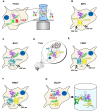Current Approaches Toward Quantitative Mapping of the Interactome
- PMID: 27200083
- PMCID: PMC4854875
- DOI: 10.3389/fgene.2016.00074
Current Approaches Toward Quantitative Mapping of the Interactome
Abstract
Protein-protein interactions (PPIs) play a key role in many, if not all, cellular processes. Disease is often caused by perturbation of PPIs, as recently indicated by studies of missense mutations. To understand the associations of proteins and to unravel the global picture of PPIs in the cell, different experimental detection techniques for PPIs have been established. Genetic and biochemical methods such as the yeast two-hybrid system or affinity purification-based approaches are well suited to high-throughput, proteome-wide screening and are mainly used to obtain qualitative results. However, they have been criticized for not reflecting the cellular situation or the dynamic nature of PPIs. In this review, we provide an overview of various genetic methods that go beyond qualitative detection and allow quantitative measuring of PPIs in mammalian cells, such as dual luminescence-based co-immunoprecipitation, Förster resonance energy transfer or luminescence-based mammalian interactome mapping with bait control. We discuss the strengths and weaknesses of different techniques and their potential applications in biomedical research.
Keywords: BRET; BiFC; DULIP; FCCS; FRET; Interactome Mapping; LUMIER; PLA; PPI analysis; Quantification of protein-protein interactions.
Figures

Similar articles
-
DULIP: A Dual Luminescence-Based Co-Immunoprecipitation Assay for Interactome Mapping in Mammalian Cells.J Mol Biol. 2015 Oct 23;427(21):3375-88. doi: 10.1016/j.jmb.2015.08.003. Epub 2015 Aug 8. J Mol Biol. 2015. PMID: 26264872
-
LUMIER: A Discovery Tool for Mammalian Protein Interaction Networks.Methods Mol Biol. 2017;1550:137-148. doi: 10.1007/978-1-4939-6747-6_11. Methods Mol Biol. 2017. PMID: 28188528
-
Lighting up multiprotein complexes: lessons from GPCR oligomerization.Trends Biotechnol. 2010 Aug;28(8):407-15. doi: 10.1016/j.tibtech.2010.05.002. Epub 2010 Jun 9. Trends Biotechnol. 2010. PMID: 20542584 Free PMC article. Review.
-
Use of BRET to Study Protein-Protein Interactions In Vitro and In Vivo.Methods Mol Biol. 2016;1443:57-78. doi: 10.1007/978-1-4939-3724-0_5. Methods Mol Biol. 2016. PMID: 27246334
-
In Vivo Analysis of Protein-Protein Interactions with Bioluminescence Resonance Energy Transfer (BRET): Progress and Prospects.Int J Mol Sci. 2016 Oct 11;17(10):1704. doi: 10.3390/ijms17101704. Int J Mol Sci. 2016. PMID: 27727181 Free PMC article. Review.
Cited by
-
Barcode fusion genetics-protein-fragment complementation assay (BFG-PCA): tools and resources that expand the potential for binary protein interaction discovery.Nucleic Acids Res. 2022 May 20;50(9):e54. doi: 10.1093/nar/gkac045. Nucleic Acids Res. 2022. PMID: 35137167 Free PMC article.
-
Detection of Heterodimerization of Protein Isoforms Using an in Situ Proximity Ligation Assay.J Vis Exp. 2018 Oct 20;(140):57755. doi: 10.3791/57755. J Vis Exp. 2018. PMID: 30394375 Free PMC article.
-
Surveying the landscape of optogenetic methods for detection of protein-protein interactions.Wiley Interdiscip Rev Syst Biol Med. 2018 May;10(3):e1415. doi: 10.1002/wsbm.1415. Epub 2018 Jan 15. Wiley Interdiscip Rev Syst Biol Med. 2018. PMID: 29334187 Free PMC article. Review.
-
Generation of an immortalized mesenchymal stem cell line producing a secreted biosensor protein for glucose monitoring.PLoS One. 2017 Sep 26;12(9):e0185498. doi: 10.1371/journal.pone.0185498. eCollection 2017. PLoS One. 2017. PMID: 28949988 Free PMC article.
-
Simultaneously measuring multiple protein interactions and their correlations in a cell by Protein-interactome Footprinting.Sci Rep. 2017 Mar 24;7:45169. doi: 10.1038/srep45169. Sci Rep. 2017. PMID: 28338015 Free PMC article.
References
-
- Cario G., Franck J. (1922). Über zerlegung von wasserstoffmolekülen durch angeregtel quecksilberatome. Z. Phys. A At. Nucl. 11 161–166. 10.1007/BF01328410 - DOI
LinkOut - more resources
Full Text Sources
Other Literature Sources

